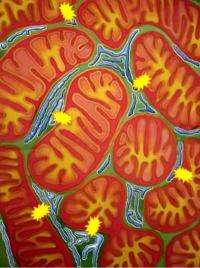Calcium connections: Basic pathway for maintaining cell's fuel stores

University of Pennsylvania School of Medicine researchers have described a previously unknown biological mechanism in cells that prevents them from cannibalizing themselves for fuel. The mechanism involves the fuel used by cells under normal conditions and relies on an ongoing transfer of calcium between two cell components via an ion channel. Without this transfer, cells start consuming themselves as a way of to get enough energy.
"Altered metabolism is a feature of many diseases, as well as aging," says senior author J. Kevin Foskett, PhD, professor of Physiology. "The definition of this essential mechanism for regulating cell energy will have implications for a wide variety of physiological processes and diseases." The investigators describe their findings in the cover article in the most recent issue of Cell.
Most healthy cells in the body rely on a complicated process called oxidative phosphorylation to produce the fuel ATP. Knowledge about how ATP is produced by the cell's mitochondria, the energy storehouse, is important for understanding normal cell metabolism, which will provide insights into abnormal cell metabolism, as in the case of cancer.
Foskett and colleagues discovered that a fundamental control system regulating ATP is an ongoing shuttling of calcium to the mitochondria from another cell component called the endoplasmic reticulum.
The endoplasmic reticulum is the major reservoir of calcium in cells. The stored calcium is released to adjacent mitochondria through a calcium ion channel called the IP3 receptor. The researchers found that this calcium release occurs at a low level all the time.
When the researchers interfered with the calcium release using genetic or pharmacological methods, the mitochondria were unable to produce enough ATP to meet the needs of the cell. This indicates that mitochondria rely on the ongoing calcium transfer to make enough ATP to support normal cell metabolism.
In the absence of this transfer, the mitochondria fail to make enough ATP, which triggers an extreme cell survival process called autophagy, or self eating.
"We discovered that this self consumption as a response to the lack of the calcium transfer appears to work in many types of cells, including hepatocytes from the liver, vascular smooth muscle cells, and various cultured cells lines," says Foskett.
Autophagy is important for clearing aggregated proteins from cells, for example in neurodegenerative diseases, and it plays a role in cancer and hypertension. The IP3 receptor plays important roles in the regulation of programmed cell death, a process that is subverted in many cancers, and in neurodegenerative diseases, including Alzheimer's and Huntington's diseases. Calcium release from the IP3 receptor may be at the nexus of neurodegeneration, cancer and the role of cell metabolism gone awry in these broad disease classes.
Provided by University of Pennsylvania School of Medicine
















